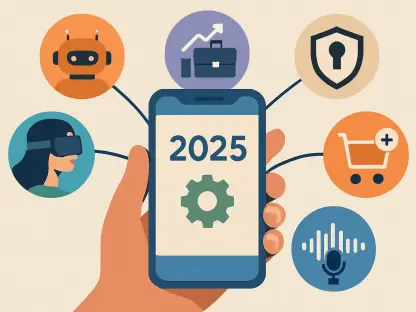Mobile user experience (UX) design plays a critical role in today’s digital landscape, where mobile devices dominate personal, professional, and commercial activities. The increasing prevalence of smartphones, smartwatches, tablets, and other wearables has mandated the necessity for superior mobile UX. With mobile eCommerce booming and search engines embracing mobile-first indexing, creating exceptional mobile UX is not a luxury but a requirement. This article delves into the principles, challenges, and collaborative processes that underpin successful mobile UX design. By understanding and addressing these factors, designers can create user experiences that are efficient, accessible, and universally appealing, thereby achieving a harmonious balance between functionality and user satisfaction.
Understanding the Significance of Mobile UX Design
Mobile UX design involves crafting seamless and positive experiences for users of mobile devices and wearables. These devices are integral to daily activities like communication, shopping, and work. Hence, UX designers must clearly understand diverse user needs and behaviors to effectively anticipate and address them. The proliferation of varied device types offers both opportunities and challenges, requiring designs that are adaptable across different platforms. This adaptability ensures that users have a coherent experience, regardless of the device they use, ultimately enhancing their satisfaction and engagement.Thorough user research is crucial in mobile UX design. By relying on empirical data about real user behaviors rather than assumptions, designers can ensure that their designs genuinely enhance the user experience. A focus on simplicity, the avoidance of unnecessary elements, and an emphasis on usability are all essential. An uncluttered interface reduces user frustration and improves overall satisfaction. Moreover, placing a premium on user-centric approaches allows designers to create interfaces that are not only functional but also intuitive, making the interaction between the user and the device as seamless as possible.
Best Practices in Mobile UX Design
Fundamental best practices pave the way for optimized mobile UX. One of the key practices is prioritizing features, ensuring that only the most essential options remain prominent and are easy to access. This prioritization helps prevent the overwhelming of users with too many choices, which can lead to decision fatigue and a less satisfying user experience. Adequate touch targets, typically between 7-10 mm, are critical to prevent user frustration and ensure smooth interactions. Additionally, text legibility is enhanced by selecting versatile typefaces and appropriate sizes, reducing eye strain and improving readability across various lighting conditions and screen resolutions.Feedback mechanisms through sound, haptics, and visual cues are vital for user interaction, providing clear information on the app’s state and responsiveness. These feedback elements reassure users that their actions have been recognized and are being processed, contributing to a smoother and more intuitive experience. Accessibility is another cornerstone of mobile UX design, emphasizing the importance of inclusive design. Following the Web Content Accessibility Guidelines (WCAG) helps create designs that cater to all users, regardless of physical, cognitive, or situational limitations. By incorporating accessibility from the outset, designers can ensure that their apps are usable by the widest possible audience, enhancing both usability and user satisfaction.
Navigating Mobile UX Design Constraints
Mobile UX design must recognize several inherent constraints to achieve optimal functionality and user satisfaction. Storage limitations necessitate that native apps optimize their design to respect user storage capacities. Excessive storage demands can lead to user dissatisfaction and abandoned apps, highlighting the importance of efficient resource management. Smaller screen sizes, prevalent among mobile devices, pose additional challenges. Designing thumb-friendly zones, reducing the number of necessary interactions, and optimizing the information hierarchy are essential strategies to mitigate these limitations and provide a seamless user experience.Environmental factors such as interrupted connectivity and frequent distractions must also be taken into account. Ensuring that users can resume their tasks effortlessly in the event of disruptions enhances the overall experience. Limited screen real estate further amplifies the necessity for self-sufficient designs that accommodate single-screen interactions, minimizing the need for context-switching and reducing cognitive load. Furthermore, the way users hold their devices, whether one-handed or two-handed, considerably influences interaction. Placing key actions centrally and ensuring sufficient touch target sizes are crucial for enhancing usability and reducing the learning curve, making the device more intuitive to use.
Collaboration with Developers: Key to Success
A successful translation of design into functional applications hinges on effective collaboration between designers and developers. Clear, finalized mockups using tools like InVision or Marvel facilitate a better understanding of the design intents. Simplifying naming conventions and maintaining consistency aids in reducing confusion during the development process. Developers can better visualize and implement designs when they have unequivocal and coherent guides, ensuring that the final product aligns closely with the initial design vision. This not only enhances the fidelity of the implementation but also speeds up the development process by reducing the back-and-forth revisions.Providing detailed functional specifications acts as a blueprint for developers, delineating expected functionalities and interactions. This step is pivotal in ensuring accurate implementation. Sharing the actual copy along with its intended usage context helps developers integrate content more effectively, maintaining cohesiveness in the final product. Specifications tools like Zeplin and InVision’s Inspect provide necessary details like measurements and style guides, giving developers comprehensive insights into the design logic. This detailed orientation allows developers to reproduce the design with precision, thereby preserving the intricacies and nuances envisioned by the designers.
Clear Communication and Continuous Interaction
Maintaining regular, direct communication between designers and developers is paramount. Timely discussions help address questions and nuances, ensuring that design elements are implemented correctly. This continuous interaction fosters a collaborative environment where both teams work symbiotically toward shared goals. Open lines of communication mean that any potential issues can be swiftly identified and resolved, preventing small problems from ballooning into significant setbacks. This level of collaboration not only leads to higher quality products but also builds a strong sense of teamwork and mutual respect among the teams.Specifications and blueprints provided to developers should be unambiguous and comprehensive, including measurements, styles, and user flows. Leveraging advanced tools and methodologies, this process is streamlined, facilitating efficient project progression and reducing instances of misinterpretation or errors. Regular communication not only helps in solving immediate issues but also builds a cohesive and cooperative team environment. By fostering an open and collaborative atmosphere, both designers and developers can contribute their unique expertise, ensuring that the final product is both aesthetically pleasing and technically flawless.
Addressing Evolving Trends and User Expectations
The future of UX design is increasingly focused on mobile, driven by the growing use of mobile devices and evolving user expectations. To stay relevant, designers must continuously adapt their strategies to meet these changing trends. A user-first approach, rooted in detailed research and simplicity, remains fundamental to effective mobile UX design. Staying informed about technological advancements and new user behaviors will help designers create more impactful and engaging experiences.Incorporating inclusivity, designers must ensure that their designs are accessible and usable by a diverse range of users. This involves paying close attention to environmental and device-specific constraints, as users interact with their devices in varied and often unpredictable contexts. Building a strong collaborative relationship with developers is equally crucial. This collaboration ensures the seamless integration of design and functionality, allowing designers and developers to anticipate potential issues and devise innovative solutions.Achieving superior mobile UX is a multifaceted but rewarding challenge that relies on understanding user needs, simplifying design, overcoming inherent constraints, and fostering effective teamwork. Adhering to these principles, designers can create mobile experiences that are not only functional but also delightful and memorable. This holistic approach ensures that users have a positive, seamless experience, leading to higher engagement and satisfaction. Ultimately, proactive, inclusive, and collaborative mobile UX design results in products that are current, adaptive, innovative, and user-friendly.









